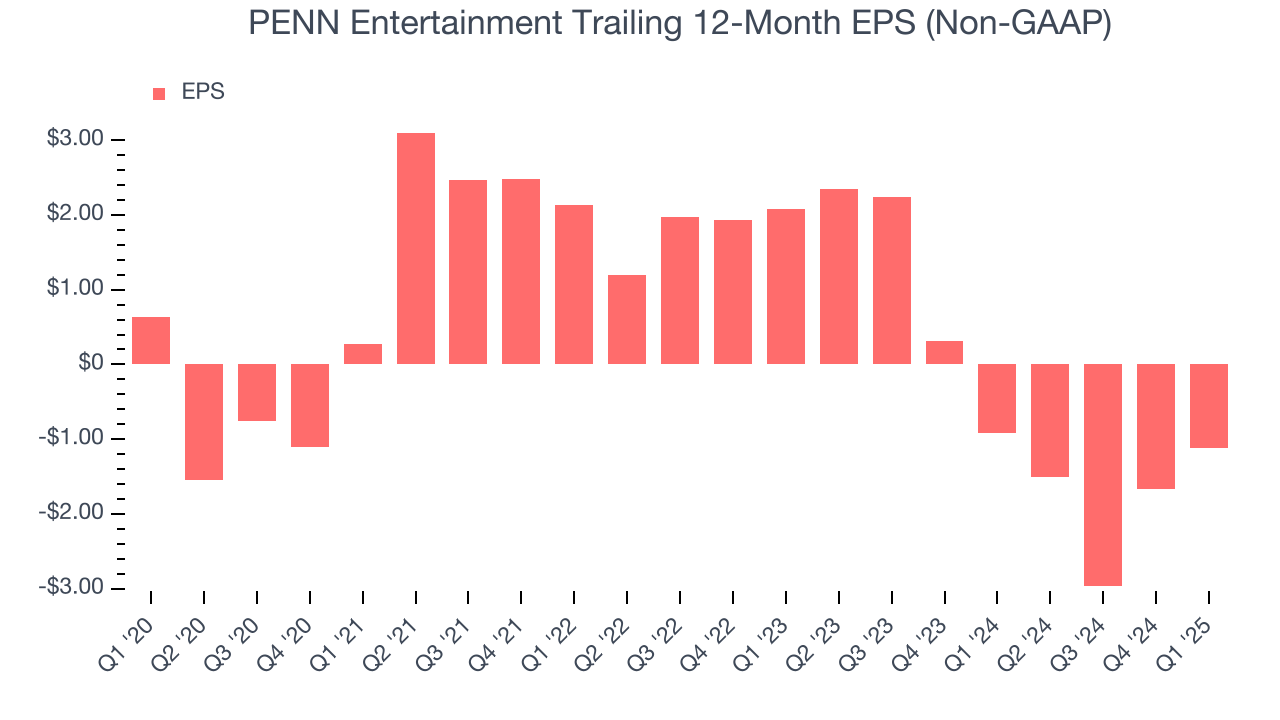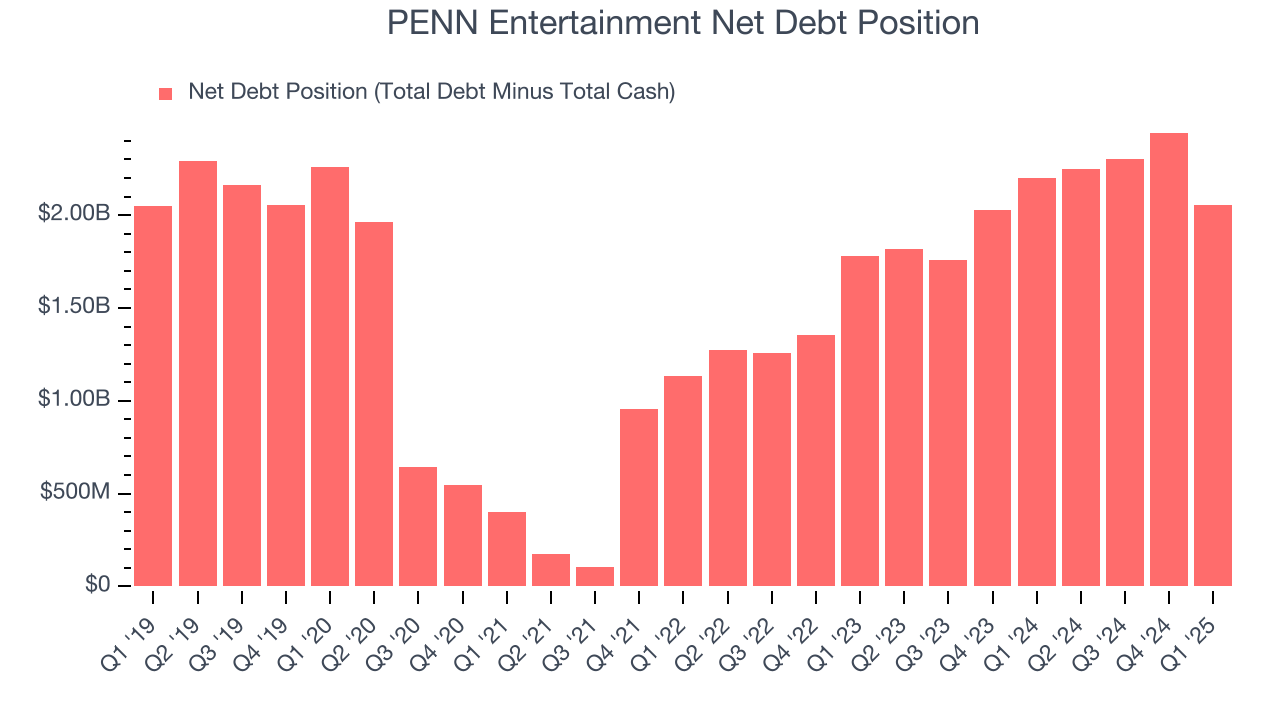
PENN Entertainment (PENN)
PENN Entertainment keeps us up at night. Its weak sales growth and low returns on capital show it struggled to generate demand and profits.― StockStory Analyst Team
1. News
2. Summary
Why We Think PENN Entertainment Will Underperform
Established in 1982, PENN Entertainment (NASDAQ:PENN) is a diversified American operator of casinos, sports betting, and entertainment venues.
- Earnings per share fell by 30.4% annually over the last five years while its revenue grew, showing its incremental sales were much less profitable
- Low free cash flow margin gives it little breathing room, constraining its ability to self-fund growth or return capital to shareholders
- Annual revenue growth of 1% over the last two years was below our standards for the consumer discretionary sector


PENN Entertainment is in the penalty box. We see more favorable opportunities in the market.
Why There Are Better Opportunities Than PENN Entertainment
High Quality
Investable
Underperform
Why There Are Better Opportunities Than PENN Entertainment
PENN Entertainment’s stock price of $17.49 implies a valuation ratio of 1.7x forward EV-to-EBITDA. The current valuation may be fair, but we’re still passing on this stock due to better alternatives out there.
We’d rather pay up for companies with elite fundamentals than get a decent price on a poor one. High-quality businesses often have more durable earnings power, helping us sleep well at night.
3. PENN Entertainment (PENN) Research Report: Q1 CY2025 Update
Casino, sports betting and entertainment operator PENN Entertainment (NASDAQ:PENN) fell short of the market’s revenue expectations in Q1 CY2025 as sales rose 4.1% year on year to $1.67 billion. Its non-GAAP loss of $0.25 per share was significantly below analysts’ consensus estimates.
PENN Entertainment (PENN) Q1 CY2025 Highlights:
- Revenue: $1.67 billion vs analyst estimates of $1.7 billion (4.1% year-on-year growth, 1.6% miss)
- Adjusted EPS: -$0.25 vs analyst estimates of -$0.07 (significant miss)
- Operating Margin: 2.6%, up from -1.3% in the same quarter last year
- Free Cash Flow was $125.2 million, up from -$110.1 million in the same quarter last year
- Market Capitalization: $2.38 billion
Company Overview
Established in 1982, PENN Entertainment (NASDAQ:PENN) is a diversified American operator of casinos, sports betting, and entertainment venues.
PENN Entertainment started as a small casino operator and has since expanded to include sports betting and entertainment venues.
Today, the company's services encompass casino gaming, sports betting, and diverse entertainment options across its properties. It has strategically embraced the surge in online sports betting, offering digital wagering alongside traditional in-person services. This approach not only caters to the classic casino-goer but also to a newer, tech-savvy audience. Beyond gaming, PENN Entertainment's venues provide a variety of dining and entertainment choices, addressing the demand for multifaceted leisure experiences.
The company's revenue streams are a blend of physical and online gaming operations, sports betting, and entertainment services.
4. Casino Operator
Casino operators enjoy limited competition because gambling is a highly regulated industry. These companies can also enjoy healthy margins and profits. Have you ever heard the phrase ‘the house always wins’? Regulation cuts both ways, however, and casinos may face stroke-of-the-pen risk that suddenly limits what they can or can't do and where they can do it. Furthermore, digitization is changing the game, pun intended. Whether it’s online poker or sports betting on your smartphone, innovation is forcing these players to adapt to changing consumer preferences, such as being able to wager anywhere on demand.
Competitors in the gaming and entertainment sector include Caesars Entertainment (NASDAQ:CZR), MGM Resorts (NYSE:MGM), and Boyd Gaming (NYSE:BYD).
5. Sales Growth
Reviewing a company’s long-term sales performance reveals insights into its quality. Any business can experience short-term success, but top-performing ones enjoy sustained growth for years. Over the last five years, PENN Entertainment grew its sales at a sluggish 5.3% compounded annual growth rate. This was below our standard for the consumer discretionary sector and is a tough starting point for our analysis.

Long-term growth is the most important, but within consumer discretionary, product cycles are short and revenue can be hit-driven due to rapidly changing trends and consumer preferences. PENN Entertainment’s recent performance shows its demand has slowed as its annualized revenue growth of 1% over the last two years was below its five-year trend. Note that COVID hurt PENN Entertainment’s business in 2020 and part of 2021, and it bounced back in a big way thereafter. 
PENN Entertainment also breaks out the revenue for its most important segment, Northeast Region. Over the last two years, PENN Entertainment’s Northeast Region revenue (casinos, hotels) averaged 1.8% year-on-year growth. This segment has outperformed its total sales during the same period, lifting the company’s performance.
This quarter, PENN Entertainment’s revenue grew by 4.1% year on year to $1.67 billion, falling short of Wall Street’s estimates.
Looking ahead, sell-side analysts expect revenue to grow 6.9% over the next 12 months. Although this projection indicates its newer products and services will spur better top-line performance, it is still below the sector average.
6. Operating Margin
Operating margin is an important measure of profitability as it shows the portion of revenue left after accounting for all core expenses – everything from the cost of goods sold to advertising and wages. It’s also useful for comparing profitability across companies with different levels of debt and tax rates because it excludes interest and taxes.
PENN Entertainment’s operating margin might fluctuated slightly over the last 12 months but has remained more or less the same, averaging 3% over the last two years. This profitability was lousy for a consumer discretionary business and caused by its suboptimal cost structure.

This quarter, PENN Entertainment generated an operating profit margin of 2.6%, up 3.9 percentage points year on year. This increase was a welcome development and shows it was more efficient.
7. Earnings Per Share
We track the long-term change in earnings per share (EPS) for the same reason as long-term revenue growth. Compared to revenue, however, EPS highlights whether a company’s growth is profitable.
Sadly for PENN Entertainment, its EPS declined by 30.4% annually over the last five years while its revenue grew by 5.3%. This tells us the company became less profitable on a per-share basis as it expanded.

In Q1, PENN Entertainment reported EPS at negative $0.25, up from negative $0.79 in the same quarter last year. Despite growing year on year, this print missed analysts’ estimates. We also like to analyze expected EPS growth based on Wall Street analysts’ consensus projections, but there is insufficient data.
8. Cash Is King
Free cash flow isn't a prominently featured metric in company financials and earnings releases, but we think it's telling because it accounts for all operating and capital expenses, making it tough to manipulate. Cash is king.
PENN Entertainment broke even from a free cash flow perspective over the last two years, giving the company limited opportunities to return capital to shareholders.

PENN Entertainment’s free cash flow clocked in at $125.2 million in Q1, equivalent to a 7.5% margin. Its cash flow turned positive after being negative in the same quarter last year, but we wouldn’t put too much weight on the short term because investment needs can be seasonal, causing temporary swings. Long-term trends carry greater meaning.
9. Return on Invested Capital (ROIC)
EPS and free cash flow tell us whether a company was profitable while growing its revenue. But was it capital-efficient? A company’s ROIC explains this by showing how much operating profit it makes compared to the money it has raised (debt and equity).
PENN Entertainment historically did a mediocre job investing in profitable growth initiatives. Its five-year average ROIC was 13.5%, somewhat low compared to the best consumer discretionary companies that consistently pump out 25%+.
We like to invest in businesses with high returns, but the trend in a company’s ROIC is what often surprises the market and moves the stock price. Unfortunately, PENN Entertainment’s ROIC has decreased significantly over the last few years. Paired with its already low returns, these declines suggest its profitable growth opportunities are few and far between.
10. Balance Sheet Assessment
PENN Entertainment reported $591.6 million of cash and $2.65 billion of debt on its balance sheet in the most recent quarter. As investors in high-quality companies, we primarily focus on two things: 1) that a company’s debt level isn’t too high and 2) that its interest payments are not excessively burdening the business.

With $744.1 million of EBITDA over the last 12 months, we view PENN Entertainment’s 2.8× net-debt-to-EBITDA ratio as safe. We also see its $224.1 million of annual interest expenses as appropriate. The company’s profits give it plenty of breathing room, allowing it to continue investing in growth initiatives.
11. Key Takeaways from PENN Entertainment’s Q1 Results
We struggled to find many positives in these results as its revenue and EPS fell short of Wall Street’s estimates. Overall, this was a softer quarter. The stock traded down 1.1% to $15.53 immediately following the results.
12. Is Now The Time To Buy PENN Entertainment?
Updated: June 25, 2025 at 10:44 PM EDT
When considering an investment in PENN Entertainment, investors should account for its valuation and business qualities as well as what’s happened in the latest quarter.
We cheer for all companies serving everyday consumers, but in the case of PENN Entertainment, we’ll be cheering from the sidelines. To kick things off, its revenue growth was weak over the last five years. And while its projected EPS for the next year implies the company’s fundamentals will improve, the downside is its declining EPS over the last five years makes it a less attractive asset to the public markets. On top of that, its low free cash flow margins give it little breathing room.
PENN Entertainment’s EV-to-EBITDA ratio based on the next 12 months is 1.7x. While this valuation is reasonable, we don’t see a big opportunity at the moment. There are more exciting stocks to buy at the moment.
Wall Street analysts have a consensus one-year price target of $21.53 on the company (compared to the current share price of $17.40).
Although the price target is bullish, readers should exercise caution because analysts tend to be overly optimistic. The firms they work for, often big banks, have relationships with companies that extend into fundraising, M&A advisory, and other rewarding business lines. As a result, they typically hesitate to say bad things for fear they will lose out. We at StockStory do not suffer from such conflicts of interest, so we’ll always tell it like it is.











